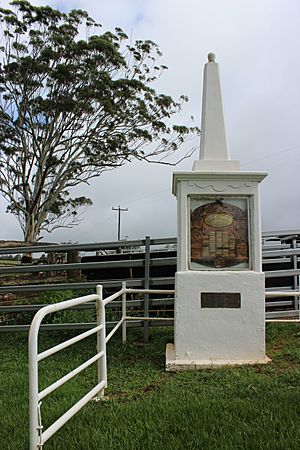Evelyn Scrub War Memorial facts for kids
Quick facts for kids Evelyn Scrub War Memorial |
|
|---|---|

Evelyn Scrub War Memorial 2017
|
|
| Location | Jonsson Road, Evelyn, Tablelands Region, Queensland, Australia |
| Design period | 1914 - 1919 (World War I) |
| Built | c. 1919 |
| Official name: Evelyn Scrub War Memorial | |
| Type | state heritage (built) |
| Designated | 28 February 2003 |
| Reference no. | 602138 |
| Significant period | 1910s (fabric) |
| Significant components | plaque, fence/wall - perimeter, flagpole/flagstaff, memorial - obelisk |
| Lua error in Module:Location_map at line 420: attempt to index field 'wikibase' (a nil value). | |
The Evelyn Scrub War Memorial is a special monument located on Jonsson Road in Evelyn, Queensland, Australia. It was built around 1919. This memorial is listed on the Queensland Heritage Register, which means it's an important historical site.
The Memorial's Story
The Evelyn Scrub War Memorial was put up after World War I (1914-1918). It was built around 1919 on land given by Edward Daniel. The memorial lists the names of 41 men from the Evelyn area who served in the war.
Back in the 1890s, Evelyn was a busy town. It was a centre for farming in the Evelyn Tableland. The town had a school, timber mills, shops, and a town hall. A railway line connected nearby Ravenshoe to Cairns, and a special tramway helped transport timber from Evelyn. Farmers grew many different crops like potatoes, maize, and fruits.
When World War I started in 1914, many young men from Evelyn joined the army. About 90% of them went to fight overseas. Some of these brave soldiers never came home. Others returned but found it hard to go back to farming. The community held special events to say goodbye to the volunteers and welcomed soldiers home.
Before World War I, Australia didn't have many public monuments. But after the war, memorials like this one became very important. They were the first national monuments, showing how much the war affected the young country. Australia lost 60,000 people out of a population of about 4 million. This was a huge loss for the nation.
These memorials became a way for people to show their sadness. They were seen as sacred, like graves for the Australians buried far away in Europe and the Middle East. The word "cenotaph" means "empty tomb." This shows how these memorials stood in for the graves of those who died overseas.
The Evelyn area faced tough times after the war. There were long droughts and a big cyclone in 1918. These events damaged farms and made life difficult. The economic problems of the 1930s also hit the area hard. The timber mills closed, and many shops and houses were moved away. The local school closed in 1946.
Today, the Evelyn War Memorial is almost all that remains of the old town. It reminds us of the soldiers who fought far away. It also shows us that this area was once a busy farming and timber community. Every ANZAC Day, a special dawn service is held at the memorial to remember those who served.
What the Memorial Looks Like
The area where the old town of Evelyn once stood is now mostly grassy fields. These fields are used for grazing cattle. There are also some timber cattle yards right behind the memorial.
The memorial is on private land, located on Jonsson Road. This road is off the main Tumoulin to Ravenshoe Road.
The monument is made of concrete. It has a strong base, called a pedestal. On top of the pedestal is a tall, pointed pillar called an obelisk. A round object sits at the very top.
A brass plaque is attached to one side of the pedestal. It is protected by a glass screen. This plaque lists the names of 41 men from Evelyn Scrub who served in the Great War. It also says what happened to them. It's interesting to note that the name of an Aboriginal person is included among those who died in service. Below this, a second plaque was added in 1983. It is dedicated to the early settlers of Evelyn Scrub.
About five metres from the memorial, on the southern side, stands a single flagstaff. There are no gardens or plants around the memorial today.
Why This Memorial is Special
The Evelyn Scrub War Memorial was added to the Queensland Heritage Register on February 28, 2003. It is considered important for several reasons:
It shows how Queensland's history has changed. The memorial, built around 1919, is a historical record of how the community and district took part in World War I. It also shows the feelings and ideas of people at that time. Since it's the last building left from the old town of Evelyn, it helps us understand how farming communities grew and then declined in the Atherton Tablelands.
It has a strong connection with the community. The memorial is a central place for ANZAC Day ceremonies. The community values it highly for its spiritual, symbolic, cultural, and social meaning.

